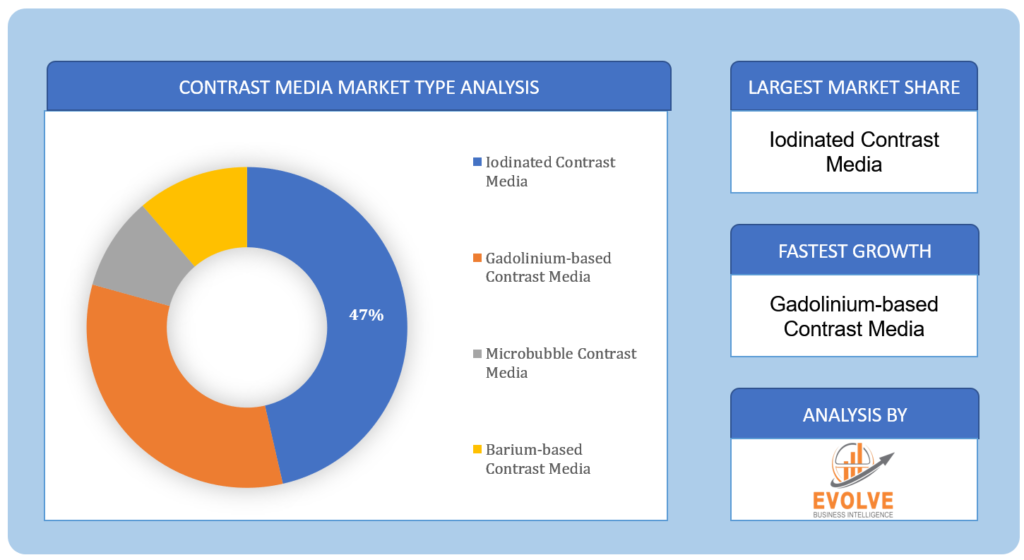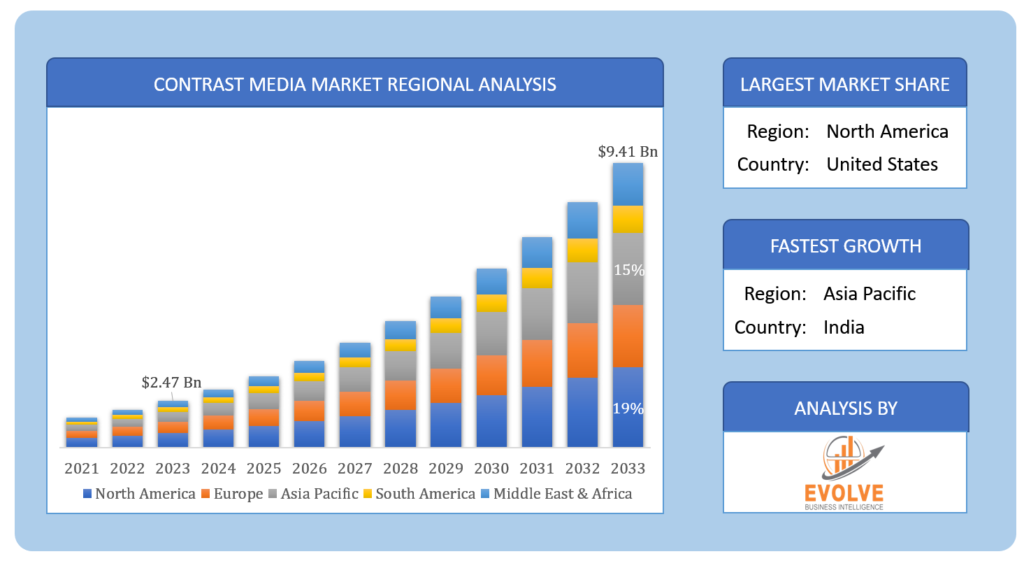The global Contrast Media market size is projected to reach approximately USD 9.41 Billion by 2033, at a CAGR of 4.06% from 2023 to 2033. Contrast media, commonly referred to as contrast agents, are chemicals used in medical imaging procedures including X-rays, computed tomography (CT), magnetic resonance imaging (MRI), and ultrasound to improve the visibility of inside structures. Typically, these medications are taken orally, injected into the circulation or other bodily cavities, or directly applied to the tissues. Depending on the imaging modality, contrast media may absorb, reflect, or emit X-rays, radio waves, or sound waves. As a result, they can aid distinguish between various tissues or structures that have similar densities or appearances in pictures. Iodine-based contrast media, gadolinium-based contrast media, barium-based contrast media, and microbubble-based contrast media are some examples of contrast media, and the choice of each depends on the imaging technique being used, the clinical indication, the patient’s health, and potential risks and benefits.
COVID-19 Impact Analysis
The Contrast Media market benefited from the COVID-19 epidemic. To identify and track COVID-19 patients, there was an upsurge in demand for diagnostic imaging techniques such as CT scans and chest X-rays. This was particularly true in the early phases of the epidemic when hospital admissions spiked and prompt identification and treatment became essential. The creation of novel contrast medium formulations and imaging methods to enhance the precision and security of COVID-19 imaging further supported the market growth.
Contrast Media Market Dynamics
 The major factors that have impacted the growth of Contrast Media are as follows:
The major factors that have impacted the growth of Contrast Media are as follows:
Drivers:
Growing prevalence of chronic disease
Chronic diseases such as cancer, cardiovascular disease, and neurological disorders require frequent and accurate imaging to diagnose and monitor disease progression. Contrast media play a critical role in enhancing the accuracy of medical imaging by providing a clear contrast between tissues, organs, and blood vessels. This helps physicians identify abnormalities, tumors, and other disease markers, and make more informed decisions about patient care. As the global burden of chronic diseases continues to rise, particularly in developing countries, the demand for Contrast Media is expected to increase significantly. According to the World Health Organization (WHO), chronic diseases are responsible for approximately 70% of all deaths worldwide, and this trend is expected to continue in the coming years. The increasing adoption of advanced medical imaging techniques, such as MRI and CT, is also driving the demand for Contrast Media. Moreover, the development of new and advanced Contrast Media formulations that are safer and more effective is further fueling the market growth. Overall, the growing prevalence of chronic diseases is expected to drive the growth of the Contrast Media market in the coming years.
Restraint:
- Side Effects and Allergic Reactions Associated with Contrast Agents
The severity of allergic reactions can vary widely, ranging from mild rash to life-threatening anaphylaxis. In some cases, these reactions can be severe enough to require emergency medical attention. These side effects and allergic reactions can not only be dangerous to patients but can also lead to a decrease in the use of contrast agents, thus affecting the growth of the contrast media market.
Opportunity:
Increasing research on contrast agents
Increasing research on contrast agents can create opportunities for the contrast media market. Contrast agents are used in medical imaging to help healthcare providers see internal body structures more clearly. As medical imaging technologies continue to evolve, there is a growing need for new and improved contrast agents that can enhance the visibility of specific tissues or organs and improve diagnostic accuracy. This need for improved contrast agents has driven increased research and development in this field. New contrast agents are being developed with different chemical structures, improved targeting capabilities, and reduced side effects. Additionally, researchers are exploring the use of contrast agents in new Procedures, such as molecular imaging and theranostics, which could lead to further expansion of the contrast media market.
Contrast Media Market Segment Overview
Based on the Type, the Contrast Media market is segmented based on Iodinated Contrast Media, Gadolinium-based Contrast Media, Microbubble Contrast Media, and Barium-based Contrast Media. During the projection period, the Gadolinium-based Contrast Media segment is expected to hold the largest market share. Gadolinium-based contrast agents are one of the most commonly used contrast agents in medical imaging, particularly in magnetic resonance imaging (MRI). These agents enhance the visibility of internal body structures by altering the magnetic properties of surrounding tissues, allowing for improved diagnostic accuracy. Gadolinium-based contrast agents are widely used in diagnostic imaging for a variety of medical conditions, including cancer, neurological disorders, and cardiovascular disease.
By Procedure
Based on the Procedure, the global Contrast Media market has been divided into X-ray/Computed Tomography (CT), Magnetic Resonance Imaging (MRI), and Ultrasound. The Magnetic Resonance Imaging (MRI) segment is expected to hold the largest market share. MRI is a non-invasive diagnostic imaging technique that uses powerful magnets and radio waves to create detailed images of the body’s internal structures. Contrast agents are often used in MRI to enhance the visibility of certain tissues or organs, allowing for more accurate diagnosis and treatment planning.
By Indication
Based on Indication, the global Contrast Media market has been divided into Cardiovascular Disease, Oncology, Gastrointestinal Disorders, Neurological Disorders, and Others. The Neurological Disorders segment is expected to hold the largest market share. Neurological disorders such as brain tumors, strokes, and multiple sclerosis often require imaging studies to diagnose and monitor the condition. As a result, the use of contrast media in these procedures is high, leading to a significant market share in the contrast media market.
Global Contrast Media Market Share, by Segmentation
 Contrast Media Market Regional Analysis
Contrast Media Market Regional Analysis
Based on region, the global Contrast Media market has been divided into North America, Europe, Asia-Pacific, and the Rest of the World. North America is projected to dominate the use of the Contrast Media market followed by the Asia-Pacific and Europe regions.
North America Market
North American region dominates the Contrast Media market. The dominance of the North American region was attributed to factors such as the high prevalence of chronic diseases, a well-established healthcare infrastructure, and the presence of major market players in the region. Furthermore, North America has a high adoption rate of advanced medical imaging technologies such as CT scans and MRI scans, which use contrast media. The region also has a large patient population, which drives demand for contrast media.
Asia-Pacific Market
Asia Pacific is expected to experience the fastest growth in the market. This was attributed to factors such as the increasing prevalence of chronic diseases, rising healthcare expenditure, growing patient awareness, and the increasing adoption of advanced medical imaging technologies in the region. In addition, the Asia Pacific region has a large patient population, which drives the demand for contrast media. Moreover, the region has a significant number of untapped markets with a growing demand for medical imaging technologies and contrast media. Furthermore, various government initiatives and investments in healthcare infrastructure in countries such as China and India are expected to boost the demand for contrast media in the region.
Competitive Landscape
The market comprises tier-1, tier-2, and local players. With their wide product portfolios, tier-1 and tier-2 players have a global reach. Since of their strategic innovations and broad regional presence, companies such as Bayer, Bracco Diagnostic Inc, GE Healthcare, and Guerbet Group lead the global Contrast Media business. To increase their market position and attract a wide consumer base, the businesses are employing various strategies, such as growth, product releases, and alliances.
Prominent Players:
- Bayer AG
- Bracco Diagnostic Inc.
- GE Healthcare
- Guerbet Group
- Lantheus Medical Imaging Inc.
- Spago Nanomedical AB
- FUJIFILM Corporation
- Beijing Beilu Pharmaceutical Co. Ltd
- Taejoon Pharm
- Trivitron Healthcare
Scope of the Report
Global Contrast Media Market, by Type
- Iodinated Contrast Media
- Gadolinium-based Contrast Media
- Microbubble Contrast Media
- Barium-based Contrast Media
Global Contrast Media Market, by Procedure
- X-ray/Computed Tomography (CT)
- Magnetic Resonance Imaging (MRI)
- Ultrasound
Global Contrast Media Market, by Indication
- Cardiovascular Disease
- Oncology
- Gastrointestinal Disorders
- Neurological Disorders
- Other
Global Contrast Media Market, by Region
- North America
- US
- Canada
- Mexico
- Europe
- UK
- Germany
- France
- Italy
- Rest of Europe
- Asia Pacific
- China
- Japan
- South Korea
- India
- Rest of Asia Pacific
- Rest of the World
| Parameters | Indicators |
|---|---|
| Market Size | 2033: $ 9.41 Billion |
| CAGR | 4.06% CAGR (2023-2033) |
| Base year | 2022 |
| Forecast Period | 2023-2033 |
| Historical Data | 2021 |
| Report Coverage | Revenue Forecast, Competitive Landscape, Growth Factors, and Trends |
| Key Segmentations | Type, Procedure, Indication |
| Geographies Covered | North America, Europe, Asia-Pacific, Latin America, Middle East, Africa |
| Key Vendors | Bayer, Bracco Diagnostic Inc, GE Healthcare, Guerbet Group, Lantheus Medical Imaging Inc, Spago Nanomedical, FUJIFILM Corporation, Beijing Beilu Pharmaceutical Co. Ltd, Taejoon Pharm, Trivitron Healthcare |
| Key Market Opportunities | Increasing research on contrast agents |
| Key Market Drivers | Growing prevalence of chronic disease |
REPORT CONTENT BRIEF:
- High-level analysis of the current and future Contrast Media market trends and opportunities
- Detailed analysis of current market drivers, restraining factors, and opportunities in the future
- Contrast Media market historical market size for the year 2021, and forecast from 2023 to 2033
- Contrast Media market share analysis at each product level
- Competitor analysis with a detailed insight into its product segment, financial strength, and strategies adopted.
- Identifies key strategies adopted including product launches and developments, mergers and acquisitions, joint ventures, collaborations, and partnerships as well as funding taken and investment done, among others.
- To identify and understand the various factors involved in the global Contrast Media market affected by the pandemic
- To provide a detailed insight into the major companies operating in the market. The profiling will include the financial health of the company’s past 2-3 years with segmental and regional revenue breakup, product offering, recent developments, SWOT analysis, and key strategies.









